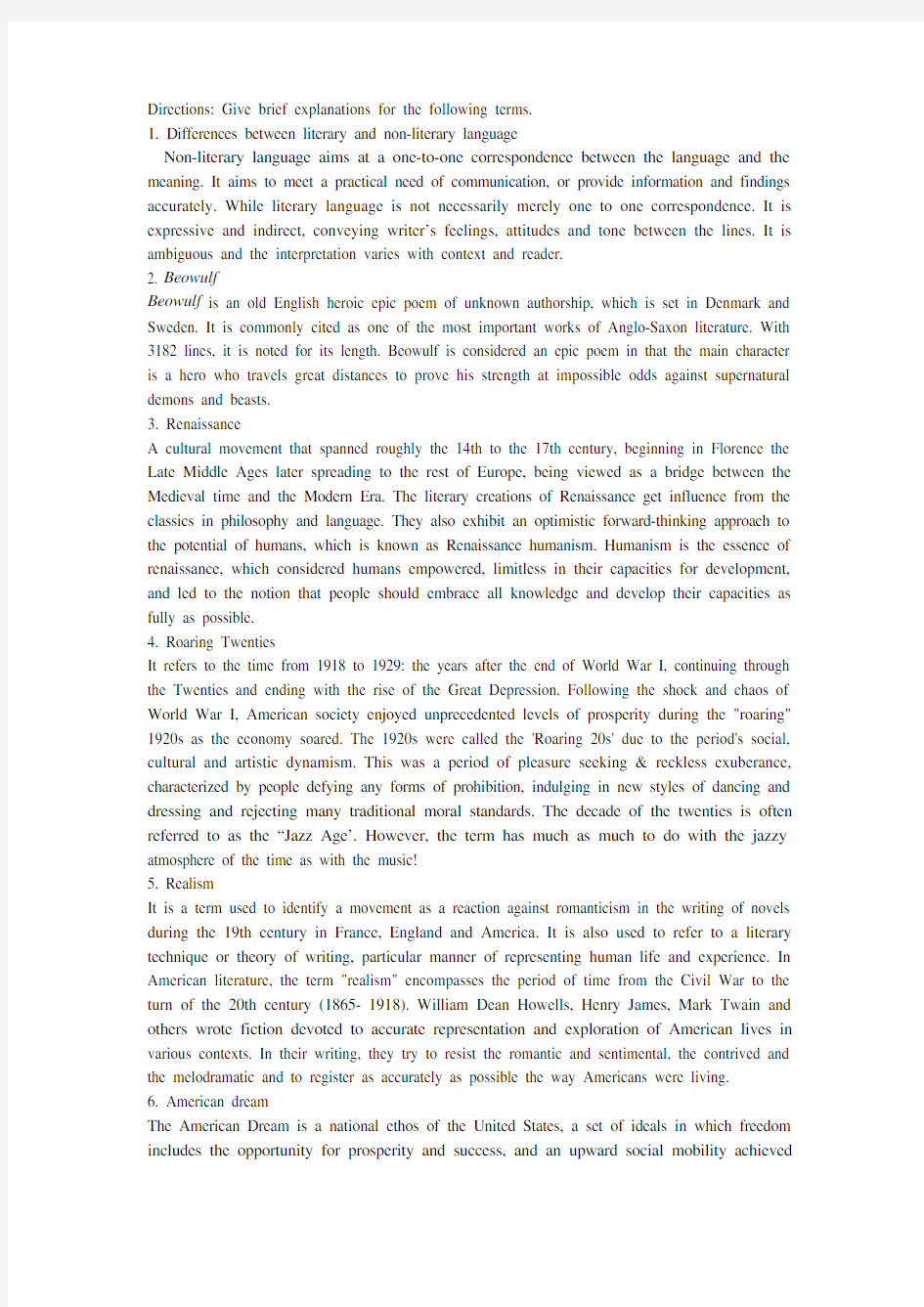英美文学名词解释

- 1、下载文档前请自行甄别文档内容的完整性,平台不提供额外的编辑、内容补充、找答案等附加服务。
- 2、"仅部分预览"的文档,不可在线预览部分如存在完整性等问题,可反馈申请退款(可完整预览的文档不适用该条件!)。
- 3、如文档侵犯您的权益,请联系客服反馈,我们会尽快为您处理(人工客服工作时间:9:00-18:30)。
Directions: Give brief explanations for the following terms.
1. Differences between literary and non-literary language
Non-literary language aims at a one-to-one correspondence between the language and the meaning. It aims to meet a practical need of communication, or provide information and findings accurately. While literary language is not necessarily merely one to one correspondence. It is expressive and indirect, conveying writer’s feelings, attitudes and tone between the lines. It is ambiguous and the interpretation varies with context and reader.
2. Beowulf
Beowulf is an old English heroic epic poem of unknown authorship, which is set in Denmark and Sweden. It is commonly cited as one of the most important works of Anglo-Saxon literature. With 3182 lines, it is noted for its length. Beowulf is considered an epic poem in that the main character is a hero who travels great distances to prove his strength at impossible odds against supernatural demons and beasts.
3. Renaissance
A cultural movement that spanned roughly the 14th to the 17th century, beginning in Florence the Late Middle Ages later spreading to the rest of Europe, being viewed as a bridge between the Medieval time and the Modern Era. The literary creations of Renaissance get influence from the classics in philosophy and language. They also exhibit an optimistic forward-thinking approach to the potential of humans, which is known as Renaissance humanism. Humanism is the essence of renaissance, which considered humans empowered, limitless in their capacities for development, and led to the notion that people should embrace all knowledge and develop their capacities as fully as possible.
4. Roaring Twenties
It refers to the time from 1918 to 1929: the years after the end of World War I, continuing through the Twenties and ending with the rise of the Great Depression. Following the shock and chaos of World War I, American society enjoyed unprecedented levels of prosperity during the "roaring" 1920s as the economy soared. The 1920s were called the 'Roaring 20s' due to the period's social, cultural and artistic dynamism. This was a period of pleasure seeking & reckless exuberance, characterized by people defying any forms of prohibition, indulging in new styles of dancing and dressing and rejecting many traditional moral standards. The decade of the twenties is often referred to as the “Jazz Age’. However, the term has much as much to do with the jazzy atmosphere of the time as with the music!
5. Realism
It is a term used to identify a movement as a reaction against romanticism in the writing of novels during the 19th century in France, England and America. It is also used to refer to a literary technique or theory of writing, particular manner of representing human life and experience. In American literature, the term "realism" encompasses the period of time from the Civil War to the turn of the 20th century (1865- 1918). William Dean Howells, Henry James, Mark Twain and others wrote fiction devoted to accurate representation and exploration of American lives in various contexts. In their writing, they try to resist the romantic and sentimental, the contrived and the melodramatic and to register as accurately as possible the way Americans were living.
6. American dream
The American Dream is a national ethos of the United States, a set of ideals in which freedom includes the opportunity for prosperity and success, and an upward social mobility achieved
